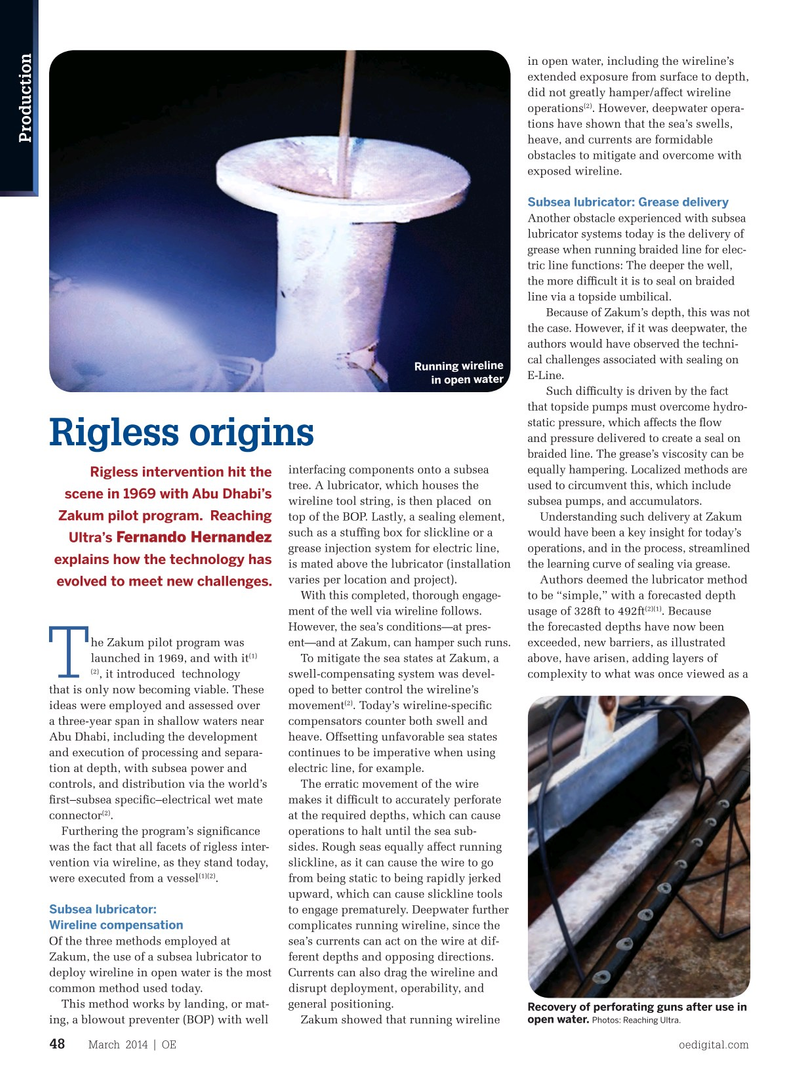
Page 46: of Offshore Engineer Magazine (Mar/Apr 2014)
Read this page in Pdf, Flash or Html5 edition of Mar/Apr 2014 Offshore Engineer Magazine
in open water, including the wireline’s extended exposure from surface to depth, did not greatly hamper/affect wireline (2) operations . However, deepwater opera- tions have shown that the sea’s swells,
Production heave, and currents are formidable obstacles to mitigate and overcome with exposed wireline.
Subsea lubricator: Grease delivery
Another obstacle experienced with subsea lubricator systems today is the delivery of grease when running braided line for elec- tric line functions: The deeper the well, the more diffcult it is to seal on braided line via a topside umbilical. Because of Zakum’s depth, this was not the case. However, if it was deepwater, the authors would have observed the techni- cal challenges associated with sealing on
Running wireline
E-Line. in open water Such diffculty is driven by the fact that topside pumps must overcome hydro- static pressure, which affects the fow and pressure delivered to create a seal on
Rigless origins braided line. The grease’s viscosity can be interfacing components onto a subsea equally hampering. Localized methods are
Rigless intervention hit the tree. A lubricator, which houses the used to circumvent this, which include scene in 1969 with Abu Dhabi’s wireline tool string, is then placed on subsea pumps, and accumulators.
Zakum pilot program. Reaching top of the BOP. Lastly, a sealing element,
Understanding such delivery at Zakum such as a stuffng box for slickline or a would have been a key insight for today’s
Ultra’s Fernando Hernandez grease injection system for electric line, operations, and in the process, streamlined explains how the technology has is mated above the lubricator (installation the learning curve of sealing via grease.
varies per location and project). Authors deemed the lubricator method evolved to meet new challenges.
With this completed, thorough engage- to be “simple,” with a forecasted depth (2)(1) ment of the well via wireline follows. usage of 328ft to 492ft . Because the forecasted depths have now been
However, the sea’s conditions—at pres- he Zakum pilot program was exceeded, new barriers, as illustrated ent—and at Zakum, can hamper such runs. (1) launched in 1969, and with it To mitigate the sea states at Zakum, a above, have arisen, adding layers of (2)
T , it introduced technology swell-compensating system was devel- complexity to what was once viewed as a that is only now becoming viable. These oped to better control the wireline’s (2) ideas were employed and assessed over movement . Today’s wireline-specifc a three-year span in shallow waters near compensators counter both swell and
Abu Dhabi, including the development heave. Offsetting unfavorable sea states and execution of processing and separa- continues to be imperative when using tion at depth, with subsea power and electric line, for example. controls, and distribution via the world’s The erratic movement of the wire frst–subsea specifc–electrical wet mate makes it diffcult to accurately perforate (2) connector . at the required depths, which can cause
Furthering the program’s signifcance operations to halt until the sea sub- was the fact that all facets of rigless inter- sides. Rough seas equally affect running vention via wireline, as they stand today, slickline, as it can cause the wire to go (1)(2) were executed from a vessel . from being static to being rapidly jerked upward, which can cause slickline tools
Subsea lubricator: to engage prematurely. Deepwater further
Wireline compensation complicates running wireline, since the
Of the three methods employed at sea’s currents can act on the wire at dif-
Zakum, the use of a subsea lubricator to ferent depths and opposing directions. deploy wireline in open water is the most Currents can also drag the wireline and common method used today. disrupt deployment, operability, and
This method works by landing, or mat- general positioning.
Recovery of perforating guns after use in open water. Photos: Reaching Ultra.
ing, a blowout preventer (BOP) with well Zakum showed that running wireline
March 2014 | OE oedigital.com 48 000_OE0314 ProdOps2.indd 48 2/21/14 12:43 PM

 45
45

 47
47